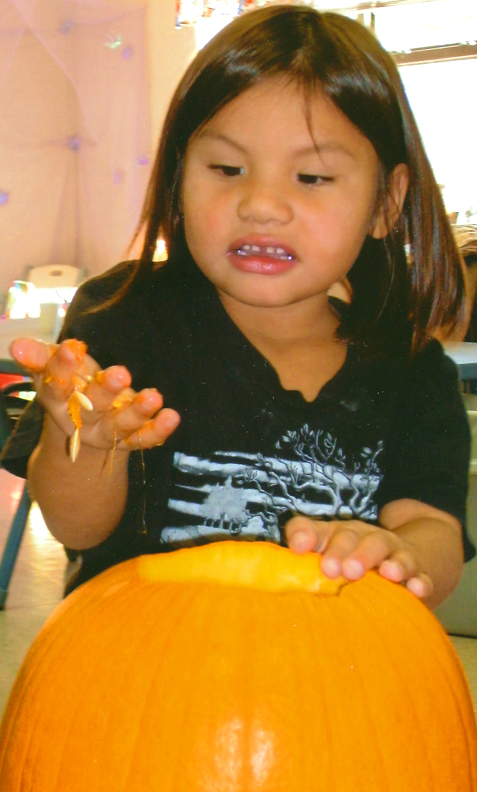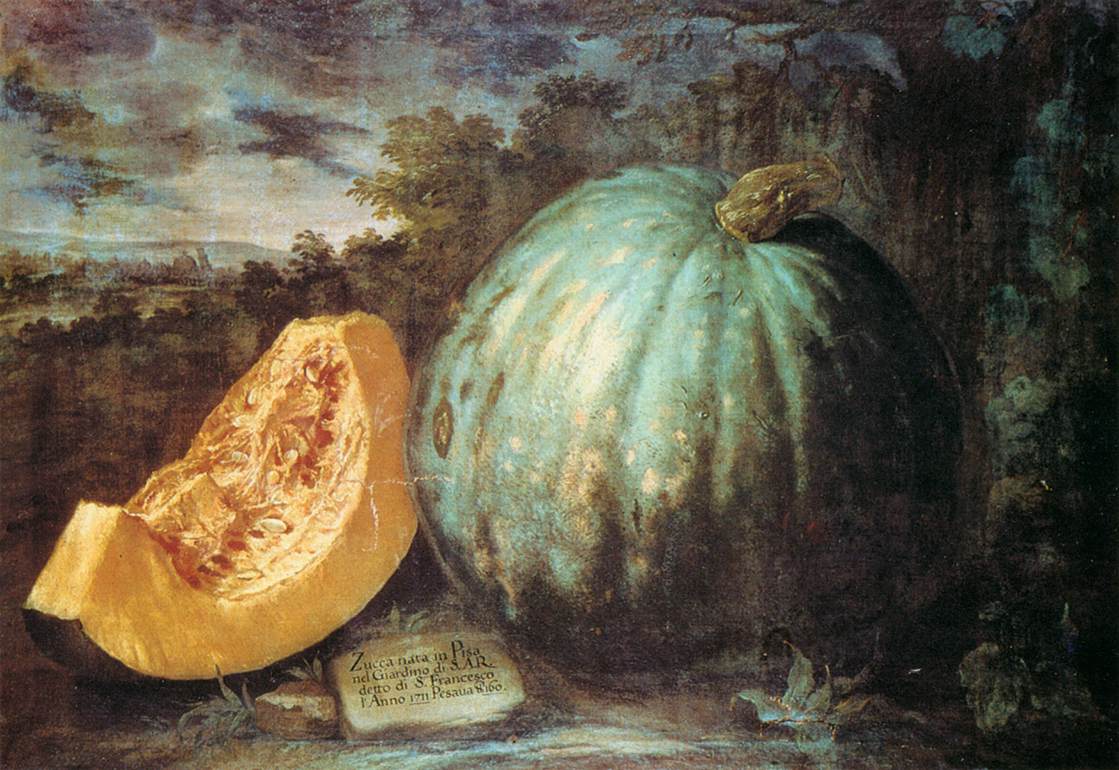Pumpkins

The pumpkin is a vegetable, but most pumpkins grown today are sold for decorating and carving. They come in all sizes and shapes, from minipumpkins, the size of apples, to giant ones, weighing over 200 pounds. Some pumpkins are gray or pale green, but most are yellow or orange. Some are even white.
Pumpkin flowers are large and yellow. Some kinds of pumpkins are grown for cattle to eat. Cucumbers, squash, melons and gourds are all related to the great pumpkin.
The pumpkin is one of only a few foods we still eat today that is native to North America. American Indians used them as food and medicine. Dried pumpkin shells served as bowls or containers for storing grains and seeds. The Indians also flattened strips of pumpkins, dried them and made mats from them.
Pumpkins were a main part of the Pilgrims' daily diet because they would keep for several months, if left uncut and stored in a cool, dry place.
Colonists made the first pumpkin pies by slicing off pumpkin tops, removing the seeds, filling the insides with milk, spices and honey, then baking it all in hot ashes.
The Pilgrims' dependence on pumpkins is reflected in this poem, from 1630. (Notice the old English "undoon" for "undone.")
Our pumpkins and parsnips are common supplies,
We have pumpkins at morning and pumpkins at noon,
If it were not for pumpkins we should be undoon.
The pumpkin is a member of the cucurbit family. Some of the world's largest fruits are pumpkins. Pumpkins range in size from less than a pound to over 1,000 pounds. According to Cucurbits, the official newsletter of the World Pumpkin Confederation, a 2005 record-breaking pumpkin weighed in at 1,469 pounds, and a giant squash tipped the scales at just over 962 pounds (436 kg).
The town of Roffstown, New Hampshire, holds an annual pumpkin regatta each October, in which giant pumpkins are hollowed out to make room for a single passenger, then fitted with trolling motors and paraded on the Piscataquog River. The tradition of carving pumpkins at Halloween started with the Irish, but the original jack-o-lanterns were made from turnips. When the Irish immigrated to the U.S., they found pumpkins a plenty, and they were much easier to carve than turnips.
The tradition of carving pumpkins at Halloween started with the Irish, but the original jack-o-lanterns were made from turnips. When the Irish immigrated to the U.S., they found pumpkins a plenty, and they were much easier to carve than turnips.
Learning Activities
 Pumpkin Guts, from "About Pnumpkins"
Pumpkin Guts, from "About Pnumpkins"Will your jack-o-lantern sink or float? If it floats add various objects to see how much weight it will hold afloat.
You must have Smart Notebook software installed on your computer to open Smart Board activities. If you have Smart Notebook software and are using Internet Explorer, you may get a message telling you the activity cannot be opened. In this event, save the activity to your hard drive. Your browser will save it as a zip file. Simply change the "zip" in the file name to "notebook," and you should be able to open it.
Thank you for your patience.
Smart Board Acitivity page
- Smart Board Activity: Pumpkin Life Cycle
(Need help?)Please be patient with us as we learn how to use this new technology.
You must have Smart Notebook software installed on your computer to open Smart Board activities. If you have Smart Notebook software and are using Internet Explorer, you may get a message telling you the activity cannot be opened. In this event, save the activity to your hard drive. Your browser will save it as a zip file. Simply change the "zip" in the file name to "notebook," and you should be able to open it.
Thank you for your patience.
Smart Board Acitivity page
If you used these facts, along with the "Fruits, Nuts, and Veggies, Oh My" booklet, please let us know by answering a few quick questions. Your class might be featured on the website as a result!
Additional Resources
- More Facts about Pumpkins
- Books about Pumpkins
- "How Does It Grow? Pumpkins" (PBS series)
- Pumpkins, Squash and Other Cucurbits, with Dora Fuqua, Canton
- Demonstration, with Zena Lewis, Owasso
- Recipes
- Poems about Pumpkins
- Theme in Yellow (Carl Sandburg)
- When the Frost is on the Punkin (James Whitcomb Riley)
Herbert Hoover and the The Great Pumpkin Wars
My uncle always raised a large quantity of pumpkins to feed the dairy cows. These would be brought in from the fields and piled in a pyramid, as much as twenty feet high by fifty feet, or more, long. We were allowed to do whatever we liked with all the pumpkins, as long as we cleaned up the debris at the end of the day and placed it in the troughs for the cows when they came home out of the woods at milking time. So we made "Jack-o-lanterns" of every sort our fancy could conceive, and arranged them by companies and battalions and brigades. Then we attacked them, foot and horse, with a corn-cutter, a weapon like a machete or a Circassion sword, and annihilated the whole army. There was no limit to the slaughter save from physical exhaustion with the rather hard chopping. It seems to me I had a companion in those battles, but his face is veiled to me now; it was probably Herbert Clark Hoover.
from Memoranda: Being a Statement by an Engineer, Theodore J. Hoover, 1939, The Hoover Blackboard, A Blog About Visiting the Hoover Library
 The Pumpkin, Bartolomeo Bimbi
The Pumpkin, Bartolomeo Bimbi
